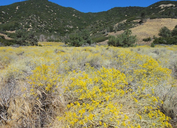Taxon Report
Ericameria nauseosa (Pursh) G.L. Nesom & G.I. Baird var. ceruminosa (Durand & Hilg.) G.L. Nesom & G.I. Bairdsharp-bracted rabbitbrush |
 Neal Kramer |
Taxon Summary
Ericameria nauseosa var. ceruminosa, commonly known as sharp-bracted rabbitbrush, is a perennial evergreen shrub in the Asteraceae that is found only in California. It occurs within Chaparral, Cismontane woodland, Great Basin scrub, Joshua tree "woodland", Mojavean desert scrub, Pinyon and juniper woodland, Riparian scrub, and Upper montane coniferous forest, growing at elevations from 780 to 1830 meters. Ericameria nauseosa var. ceruminosa is ranked 4.2, Plants of Limited Distribution, A Watch List; Moderately threatened in California.Classification
|
Scientific Name: |
Ericameria nauseosa (Pursh) G.L. Nesom & G.I. Baird var. ceruminosa (Durand & Hilg.) G.L. Nesom & G.I. Baird |
|
Common Name: |
sharp-bracted rabbitbrush |
| Family: | Asteraceae |
| Element Code: | PDAST2C0GD |
| USDA Plants Symbol: | ERNAC3 |
|
Synonyms/Other Names: |
|
Ecology and Life History
| Lifeform: | perennial evergreen shrub |
| Blooming Period: Sep-Oct(Nov) | Sep-Oct(Nov) |
| Elevation: | 780-1830 (2560-6005) |
| General Habitats: | Chaparral, Cismontane woodland, Great Basin scrub, Joshua tree "woodland", Mojavean desert scrub, Pinyon and juniper woodland, Riparian scrub, Upper montane coniferous forest |
| Microhabitat: | Alkaline (sometimes), Granitic (sometimes), Gravelly (often), Sandy (often) |
| Microhabitat Details: | Usually in dry areas within washes, river bottoms, alluvial plains, or alkaline basins on flats or gentle slopes. |
Conservation Status
| CA Rare Plant Rank: | 4.2 |
| Global Rank: | G5T2T3 |
|
State Rank: |
S2S3 |
| State List: | None |
| Fed List: | None |
| Other Status: | |
|
CRPR Changes: |
|
Occurrence Data from the CNDDB
| Total Occurrences: | 0 |
| Element Occurrence Ranks: | |
| Excellent (A) | 0 |
| Good (B) | 0 |
| Fair (C) | 0 |
| Poor (D) | 0 |
| None (X) | 0 |
| Unknown (U) | 0 |
| California Endemic: True | |
| California Counties and Islands: Name (Code) | |
| Quads: Name (Quad Code) | |
Threat List Data from the CNDDB
| Threat List Total: | 0 | |
| EOs with Threat Listed: | Total EOs | % of EOs |
| 0 | 0 % | |
Selected References
| Proposed addition to CRPR 4.2, G5T3 / S3 (2024) |
| The Academy of Natural Sciences of Philadelphia 3 (second series): 37–46 (1855) |
| Phytologia 75: 74–93 (1993) |
Citation
California Native Plant Society, Rare Plant Program. 2025. Rare Plant Inventory (online edition, v9.5.1). Website https://www.rareplants.cnps.org [accessed 17 December 2025].